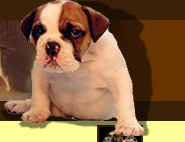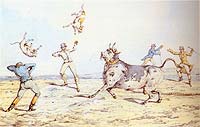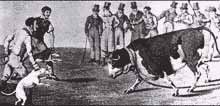Although she had scarcely a tooth in her head, the bitch immediately pinned the bull. The butcher then cut her to pieces with a hedge-bill, and she only quitted her hold with her last breath. There was instantly a great demand for her puppies which the butcher sold for five guineas apiece.
Another man, confident of the pure blood and intensive courage of his dog, proposed a trifling wager: that he would at four distinct intervals deprive the animal of one of his feet by amputation, and that after every individual deprivation, the dog, on his stumps, would continue to attack the bull. The dog attacked as his master had predicted. His master then called him off, and as soon as the dog had limped bleeding into his master's arms, cut off his head-certainly the more merciful action of the two.
The following anecdote of a Bulldog bitch appeared in Sporting Magazine, January 1824: A butcher brought a bitch accompanied by her litter of puppies to a bull-bait. Upon letting the bitch loose, the butcher exclaimed, "Now gentlemen, I will say nothing of the goodness of this breed; you will see."
One writer reports that he has seen a Bulldog pin an American bison and hold its nose down until the bison finally brought forward its hind feet and crushed the dog to death; the bison's muzzle, most dreadfully mangled, was torn out of the dog's fangs.
It was not uncommon to see the dogs at early English baits, with their entrails trailing on the ground, urged again and again to run at the bull they were baiting. In one case, a dog of great repute was gored by the bull so that his bowels were torn out.


Securing them in their place with needle and thread, the spectators, in consequence of some wager depending upon the outcome of the baiting, then set the dog at the bull in this mangled and almost dying condition.
The following, a typical public notice, appeared in the Weekly Journal: "July 22, 1721, note: also a bear to be baited and a mad green bull to be turned loose in the Gaming-place; with fireworks all over him and a comet at his tail, and Bulldogs after him. A dog will be drawn up with fireworks after him in the middle of the yard; and an ass to be baited upon the same stage."
It was not unusual at a bull-bait to see a Bulldog, surrounded by fireworks, raised to a considerable height by a rope which was drawn up through a pulley arrangement. The dog maintained his position of safety above the flames by holding tight with his teeth to a piece of sponge attached to the end of the rope.
As an additional means of attracting spectators, boxing matches were sometimes held in conjunction with bull-baits. It is recorded that almost five thousand spectators witnessed an 1824 bull-bait which was followed by a boxing match.
In many towns the butchers were liable to a penalty if they sold the flesh of a bull in the market without having had the animal baited on the previous market day. The reason for this was that the flesh of a baited bull was universally considered more tender and nutritious than that of animals slaughtered without first being submitted to the process. The belief, while it does not excuse the brutality of the act, may have been founded on fact. The excited state of the animal just before death would have tended to hasten putrefaction, and the flesh would have had to be cooked sooner or it would have been unfit to eat.
There can be little doubt that bullbaiting, as practised by the early English, was not merely a cruel sport intended to gratify the lowest and basest passions, but also was intended as a means of rendering wholesome and nutritious a large quantity of flesh that otherwise would not have been utilised.
In the old Court Roll of the Manor at Barnard Castle, it is stated that "no butcher shall kill any bull two years old upwards, unless he first be brought to the ring and sufficiently halted." The ring in Barnard Castle (fixed in a large stone that was level with the pavement) was in the Market Place opposite the District Bank. Bulldogs of a strain known as "Lonsdales," named for Lonsdale, a butcher and publican who lived at Barnard Castle about 1780, were in demand for many years.
In 1802, after a very heated discussion, a bill to abolish bull-halting was thrown out of the House of Commons. The practice continued until 1835 when it was made illegal by an Act of Parliament.
Bull-bailing continued to be practised occasionally at the West Derby Wakes until about 1853, and baits were held at Wirksworth as late as 1838 or 1840. The last bull-bait in Aylesbury took place on September 26, 1821. At Ashbourne the final bait was held in 1842, while at Lancashire the practice continued until about 1841 or 1842. It is interesting to note how many years passed after the Act of Parliament before the custom died out completely.
With the decline of bull-baiting, the number of pure-bred Bulldogs began to diminish rapidly. One early writer states that they Were occasionally to be obtained in London and Birmingham and a few scattered places in the Black Country.
An engraving of Wasp, Child, and Billy, published May 15, 1809, -bore the following account in the margin: "The above Bulldogs, the property of H. Boynton, Esq. originally of the late Duke of Hamilton's breed, and the only ones left of the blood, are in such high estimation that Mr. Boynton has received one hundred and twenty guineas for Billy, and twenty guineas for a whelp before taken from the bitch. It is asserted that they are the only real Bulldogs in existence, and upon their decease this species of dog may be considered as extinct."
The sport of dog-fighting which succeeded bull-baiting in public fancy, was largely responsible for the diminishing number of pure-bred Bulldogs. Many breeders began crossing the Bulldog with the Terrier because they felt that such a cross produced a better fighter.
It was in 1835, that the bull-and bearbaiting contests, as well as dogfighting, were finally prohibited by law.

.
.
.
.
See also:
Cute puppies, a collection of
cute and funny puppy photos
The
Bulldog Information Library 2003-2010 © All rights reserved. Original idea, design and development by C. Marien-de Luca.
No part of bulldoginformation.com may be copied, distributed, printed or reproduced on another website without the owner's written permission. Please feel free to link from your site to any of the pages on this website in a non-frame presentation only.
Bulldogs for Dummies
by Susan M. Ewing
Better Food for Dogs
David Bastin
Dog Owner's Home Veterinary Handbook
by James M. Giffin, Liisa D. Carlson
More information:
UC Davis Book of Dogs :
The Complete Medical Reference Guide for Dogs and Puppies
Bulldog Information 2003-2010 © All rights reserved.















